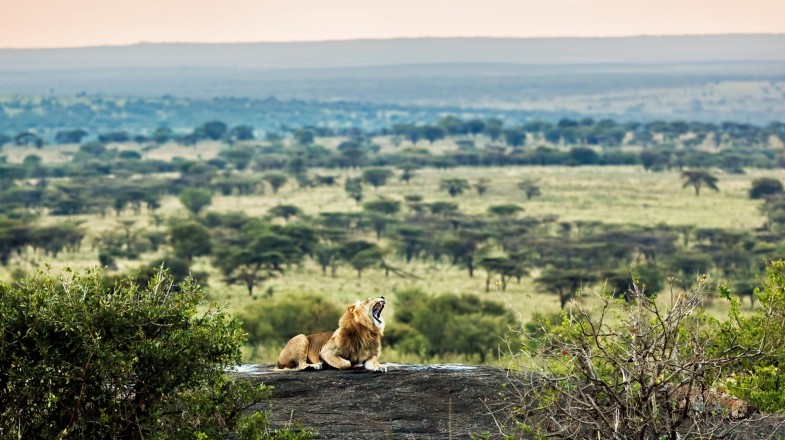Home to the largest concentration of wildlife on the African continent, Tanzania’s national parks offer an unparalleled safari experience. Picture yourself amidst the Great Migration, where over two million wildebeest, zebras, and gazelles journey through the Serengeti. This natural spectacle is among the most breathtaking wildlife events on the planet.
Putting Tanzania’s conservation efforts into perspective, the country has dedicated nearly 40% of its land to protected areas. This commitment dates back to the 1950s when efforts to preserve the breathtaking landscapes began. Today, parks like Ngorongoro Conservation Area and Tarangire showcase not just diverse wildlife but also an intricate balance between nature and local cultures.

Explore the Rich Wildlife of Serengeti National Park
The Serengeti National Park is renowned for its incredible wildlife diversity. Home to over 500 bird species and 70 large mammal species, the park promises a thrilling safari experience. Visiting during the Great Migration season is particularly exciting. Millions of wildebeest and zebras move in search of fresh grazing. This spectacle is one of nature’s most impressive events.
One of the highlights of Serengeti is the chance to see the Big Five. Lions, elephants, buffalos, leopards, and rhinos roam freely in their natural habitats. Spotting these magnificent animals is a memorable experience. According to the article, the park’s vast plains make it an ideal spot for photography. Capture the moments of predators stalking their prey.
The park also fosters a unique balance between wildlife and the Maasai community. The Maasai people, known for their distinctive customs and dress, live near the park. Engaging with them provides a cultural experience. You can learn about their traditions and daily life. This adds a human element to your wildlife adventure.
For those looking for luxury, there are several high-end camps available. According to this post, these camps offer comfort and stunning views. They’re perfect for unwinding after a day of adventure. Star-gazing in the Serengeti’s clear night sky is unmatched. The perfect end to an exhilarating day in the wild.
Delve into the diversity of species and the annual Great Migration
The Serengeti is a tapestry of life, weaving together a multitude of species. From the elegant giraffes towering over acacia trees to tiny, industrious dung beetles, every creature plays a role. Elephants traverse long distances in search of water, demonstrating their incredible strength and intelligence. Predators like cheetahs and lions showcase agility and teamwork. This diverse ecosystem creates a complex and engaging wildlife chain.
Witnessing the Great Migration is a highlight for any visitor. During this time, over two million animals move across the Serengeti. They travel in search of fresh grazing grounds and water. The migration journey is filled with challenges as animals face predators and rivers. Watching this natural wonder unfold is both thrilling and humbling.
Bird watchers will find the Serengeti a paradise. There are over 500 bird species, including the vibrant lilac-breasted roller and scavenging vultures. These birds, each with unique calls and colors, add a melodic soundtrack to the park. Here are some of the notable birds you might spot:
- Secretary bird
- Tawny eagle
- Grey-crowned crane
- Ostrich
The movement patterns of the Great Migration have huge ecological effects. Large herds help rejuvenate grasslands by trampling and fertilizing the soil. This cycle supports countless other species, reinforcing the park’s biodiversity. Such interactions demonstrate the intricate balance of nature. Understanding these relationships enriches our appreciation of the Serengeti.
Uncover the Wonders of Ngorongoro Conservation Area
Ngorongoro Conservation Area is a remarkable blend of wildlife and human history. It’s home to the vast Ngorongoro Crater, a caldera teeming with life. Within the crater’s 100 square miles, you’ll find diverse habitats like grasslands, swamps, and forests. Over 25,000 animals live here, including endangered black rhinos. The crater walls provide a natural enclosure, creating an ideal setting for spotting wildlife.
Besides animals, Ngorongoro is historically significant, with archaeological sites like Olduvai Gorge nearby. This site is known as the “Cradle of Mankind” due to ancient human fossils found there. Visiting these sites offers a glimpse into early human history. It underscores the area’s importance not only for wildlife but also for anthropology. Learning about human origins is a fascinating part of the Ngorongoro experience.
The Maasai people are integral to Ngorongoro’s culture. They continue to live in the area, herding cattle and maintaining their traditions. Engaging with the Maasai offers insights into their way of life. It reflects a harmonious relationship between humans and nature, unique to the conservation area. Such interactions enrich the visitor’s experience.
Visitors can enjoy various activities in the conservation area. These include game drives, guided nature walks, and cultural visits to Maasai villages. Here’s a list of things you can do:
- Visit the Ngorongoro Crater
- Explore Olduvai Gorge
- Engage in Maasai cultural tours
- Join a game drive to spot wildlife
Key Takeaways
- The Serengeti is home to a vast array of species.
- The Great Migration features millions of animals moving across the park.
- Ngorongoro Crater hosts over 25,000 animals within its walls.
- Olduvai Gorge offers insights into ancient human history.
- Engaging with the Maasai people showcases a unique culture.
Final Thoughts
Exploring Tanzania’s national parks offers a unique blend of wildlife, culture, and history. The Serengeti and Ngorongoro Conservation Area stand out with their incredible biodiversity. They provide an unforgettable experience for any nature enthusiast.
Whether witnessing the Great Migration or engaging with the Maasai people, each visit is enriching. The commitment to conservation ensures these wonders remain protected. Tanzania invites you to explore its majestic landscapes and vibrant ecosystems.

